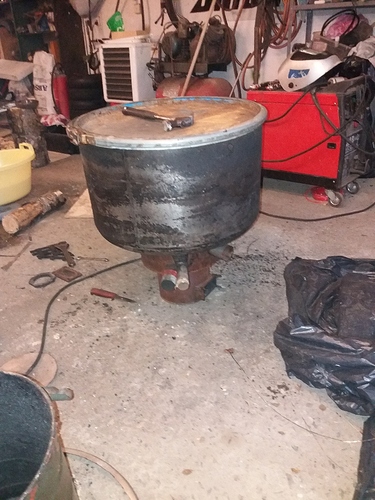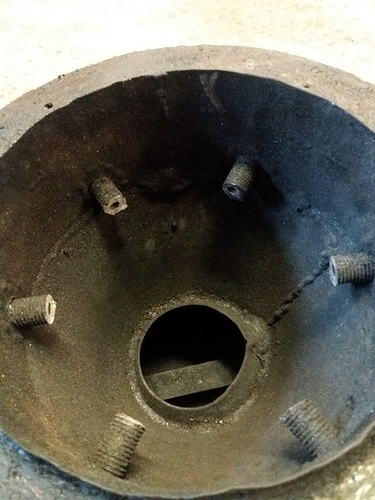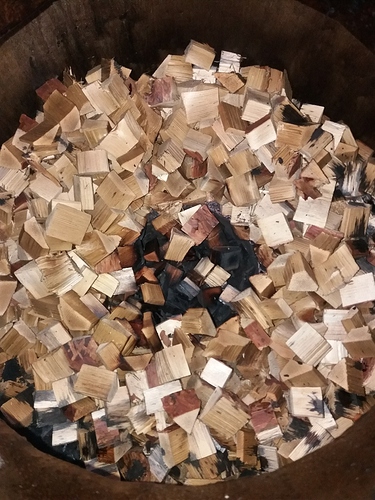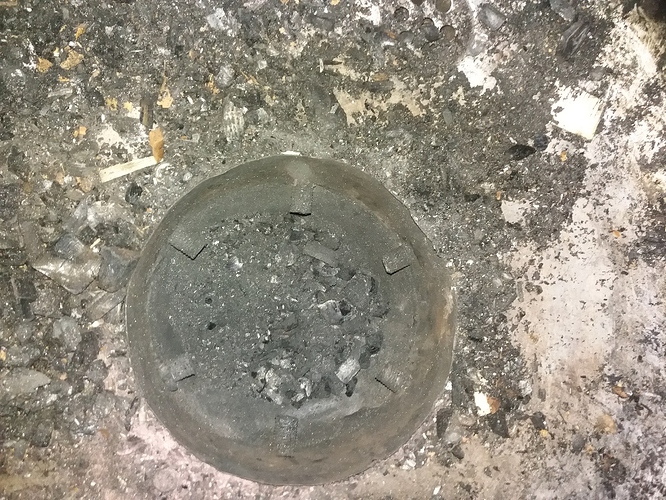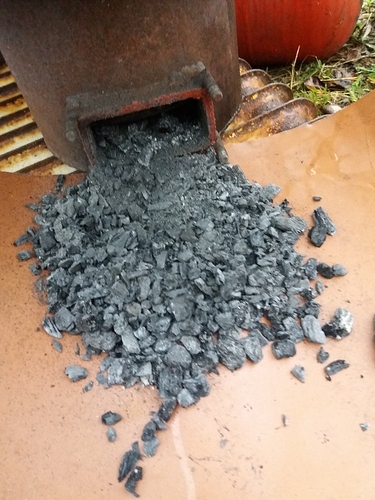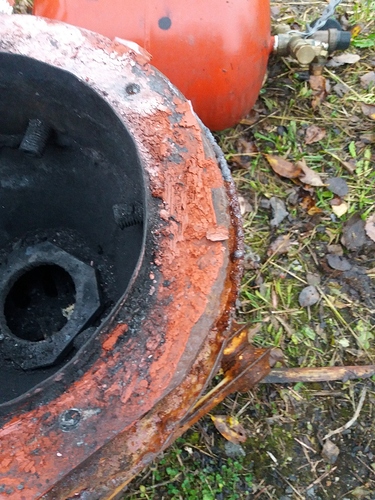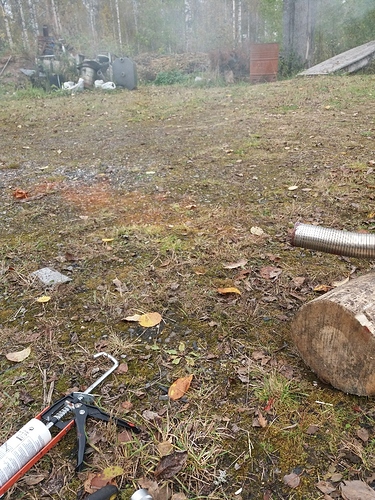Hi Jan,
Any air “leaks” lessen the velocity of the air exiting the
nozzles. This in turn, of course, lowers the temperature
in the most important place where you want the highest temps
for conversion. Yes, it directly affects the quality of the gas
produced. Pepe
Yes, you are probably right, I can try to make a new top for this hopper, can use it even if I do a new bottom later.
Ha, the experimental stage is the most fun stage. I’m a little envious ![]()
This is what comes to my mind:
Square chunks will bridge more easily. Size sounds ok though. Use roundies, or at least mix some in.
Use only really dry chunks. There will be excess water in the wood, cooling the process, no matter how dry.
If it doesn’t wash off your fingers with water only, it is tar. Dripping wet soot is normal.
Don’t get me wrong, just checking for the obvious: Did you prefill the gasifier with small charcoal to above nozzles?
For better flow, cut out the plastic screens on the fan. Inlet and outlet.
Jan; I know that the fellows who have leaned the 80% needed to run a gasifier, can just throw the wood in light it and wait for a minute or so, and take off down the road. As a beginner, I suggest you put charcoal in the bottom up to above the nozzles, put some of the dry good sized and best shape wood pieces onto of the char. Then take a metal rod and poke down through the wood and char down to the grate. Wiggle it around to kind of create a conical hole. Turn the vacuum on and stick your torch down in the hole for a minute or two. You should hear a roaring sound. Let it run for another two or three minutes, taking your rod and just poking around on top of the wood to get it to fall into any cavity that is created by the fire. NOW! My big suggestion. Open the lid, and turn your blower around so it is “blowing” into the ash pit or pipe coming out of the ash pit. Let it blow and the smoke should really start rolling out of the hopper. (I hope you are out of doors) The smoke coming out will and should be WHITE like the clouds in the sky. That is steam coming out. KEEP BLOWING. Soon you will see some grundgy brown smoke coming in the center of the white. Keep blowing. When the smoke comming out is 80-90% brown, stand to the side and pass the torch over the open hopper lid. If the gas is ready, the smoke should ignite and disappear. It will be replaced by an almost clear flame down in the hopper. You are now ready to turn the blower over to vacuum again and close the lid. Try a flare or start cranking the engine over. It should be a GO! TomC PS This does take 5 or 10 minutes, but you will be starting up with out tar.
TomC: I’ll try your tip, see how it works, but have to fix the lid, otherwise I’ll think about it all the time.
Thank you all for helping me.
JO: Well, I get a little frustrated, it gave so nice gas before and nothing at all now, Hmm.
No, I did not fill with coal up to the injection, thought it was enough with the old, but you are probably right, because the lid leaks so much, probably the coal would have burned out.
Began to copy JO’s firewood, must try to follow my teacher.
Hi teach me me today what the plate on the inside should be, i has to look at it too.
Jan; I agree that JO is a good teachder and one to eminate. My problem for openers was; where do you guys get those SS wash tubs to use for hoppers. I resorted to usning a cut down 55 gal drum. It is cut down so that it doesn’t stick up above the cab of my truck— but the 55 gal drum is much smaller in diameter. I have ended up with much less volume in my hopper. TomC
Jan, that´s exactly the kind of hopper I would have chosen 
@TomC The diameter is exactly the same as a 55 gal drum. That´s why it´s possible to use a drum lid and locker ring.
I prefer an odd number of nozzles, tends to promote a
rotation of the flame and IMO promotes improved mixing
and combustion and possibly promotes a higher temp.
Now I have tested with dry wood, made small pieces.
The gas does not burn, almost no gas at all.
Tried to push in the air, but only pushes the lid to open and all gas goes out there.
Water filled the unit, and it looks just right, no leaks.
Seems like it will be too compact in the grate?
Grate plugged?
When running low demand a pull-through grate will most likely plugg with ash. Especially running several short bursts. Do you use a grate shaker? A certain velosity is needed to keep a pull-through grate clean without one.
I didn’t use a grate shaker in the Rabbit gasifier and I sometimes had to go WOT for 15-20min before things losened up.
A proven by-pass grate is probably the best option.
JanA,
Grates can be made continuous all-across so ALL gases must flow through them. Slot spacing becomes critical. Gases flowing velocity becomes critical to keep the grate cleared of ash allowing flow.
A bypassing grate means one that would allow gasses to flow out across the outer edges IF the center of the grate became flows clogged.
Either type can be shaken/agitated as needed.
Your final picture shows your no-burnable gas problem.
80% of those wood char chunks should have been held up above the grate and been glowing hot to be your gasses REDUCTION zone.
Reduction is the thermal-chemical simplification of upper system made, non-combustible CO2, H2O into the simpler, then combustible gases of CO, and H.
The glowing reduction zone charcoal giving up the more needed C’s and heat energy to do this conversion.
Regards
Steve unruh
I wonder if I did the problem by bumping the coal with the iron myself?
I will seal the lid a little better and then run a longer time to see if it works.
I tested today with everything except the filter cloth, seemed to work even then, probably fired 5-10 minutes, but still have a gray smoke right at the nozzle?
Is a hay filter as good as cork?
Have never read about hay filters in old writings.
Ha, I never heard of hayfilters either, until I stumbeled on DOW. My guess is @Wayne had more hay at hand than he did cork trees at the time he started his adventure 
I never tried cork and I don’t know much about what it should look like when flaring. I’ve flared once with each gasifier, but it was dark outside on both occasions.
In my long post on starting your gasifier, I think you missed my point. I was suggesting that you "open’ the lid and start blowing backwards through the gasifier. First part about putting the rod down through the bed and lighting through the hole created by the rod, with a vacuum pulling was to get a good hot fire going in the char. Have the lid closed while waiting for the fire to really get roaring. Then “open” the lid and turn the fan around to blow backwards. Smoke should just ROLL out of the hopper. It will probably be “white” meaning it is steam from the wood. As the wood dries out the smoke will turn brown. Once you get almost solid brown smoke, the wood is dry, close the lid ( you can put in some new chunks of it is burned down) and turn on the vacuum and try for a flare.
Another trick to try is put a tin can or something like a tail pipe extension over the end where you are lighting the flare. This slows the gas down a little and mixes air to give that mix of air and gas you need, like in an engine. TomC
PS If you get a design that works for sealing your lid POST IT. I’ve built sooo many designs and mine still leaks.
Tom, I don’t know if you saw it, but I have a flame, think only a little water vapor is in the mouth of the pipe.
Yes, agree with the lid, we will hear with JO, if his new lid is tight.
No, it’s not tight at all. The hopper sneezes twice a mile. Away from home I shut down a minute or two early to avoid embarrasment. I’ll give it a few more cycles to see if tar will make the rope seal.
Also, Kristijan reported the other day stove ropes like to split when tar starts to glue it to the mating surface. We’ll see. I may be back to silicone or rubber shortly.
Jan A. That vapor in your flare is what made me think you had not blown back until you had the vapor gone and were down to the start of pryolisis. TomC
